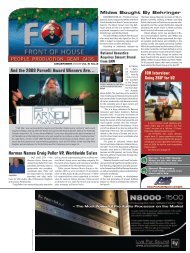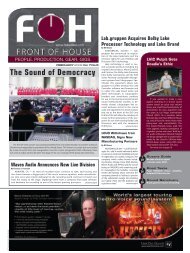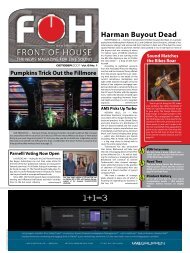Create successful ePaper yourself
Turn your PDF publications into a flip-book with our unique Google optimized e-Paper software.
Ad info:http:// foh.hotims.com<br />
46<br />
Theory and Practice<br />
Generators:<br />
Size Counts By<br />
When forced with the option<br />
to use portable generators<br />
for live production, there are<br />
aspects that most sound engineers<br />
do not understand. While install power<br />
connections are reasonably lightly<br />
loaded for the audio watts provided,<br />
the nature of the current demands<br />
will vary with the music intensity of<br />
the performance and needs to be<br />
considered with portable power.<br />
Yes, there are stories of success<br />
using small generators designed for<br />
the RV and household emergency<br />
power markets; these scenarios are<br />
very conscious of the limitations and<br />
the gear is minimal to do the gig. A<br />
typical rock ‘n’ roll show, even with<br />
local talent production standards<br />
and modest audience, can draw tens<br />
of thousands of “peak” watts during<br />
the course of the event. No gennycart<br />
I know of would survive that kind<br />
of show; and if the constant breaker<br />
tripping doesn’t get you, the possibility<br />
of equipment damage due to<br />
under voltage and under frequency<br />
is likely.<br />
Understanding the Load T P<br />
So, how do you size a generator?<br />
Well, a fair and conservative assessment<br />
of the power “loading” needs<br />
to be done. Audio equipment like<br />
mixing consoles, signal processing<br />
and wireless equipment are the easy<br />
items because they mostly draw consistent<br />
current at 120 volts AC. But<br />
audio power amplifiers are where<br />
things get difficult. The good news<br />
is that the higher frequency audio<br />
signals are filtered by the power supplies<br />
within the amplifiers and just<br />
the amplitudes of the signals are<br />
brought back as power supply demand.<br />
So, the amplifiers will draw<br />
based on the loudness demands<br />
throughout the show.<br />
For instance, subwoofer power<br />
amplifiers will draw power in impulses<br />
as each kick drum hit occurs and<br />
bass guitar note attack sounds. The<br />
power distribution will see an ampere<br />
or two continuously with 10 ampere<br />
or more impulse draws to replenish<br />
in the internal amplifier power supply<br />
as the source material demands.<br />
The midrange and high frequency<br />
power amplifiers also have the same<br />
crescendo demands, but typically the<br />
impulses are wider and less intense.<br />
Given all the amplification with each<br />
amp’s internal power supply needing<br />
replenishment with the source audio,<br />
the power distribution and portable<br />
generator peak/average demands<br />
vary a lot.<br />
Genny Design T P<br />
Generator designers are not dumb<br />
engineers, and they do understand<br />
that some load tasks will require a<br />
lot of peak current demand with lower<br />
average demand. To accomplish<br />
the provision for peaks, the electric<br />
AC generator transfers the electrical<br />
demand back as resistance to shaft<br />
rotation of the generator’s armature.<br />
To counter this variable mechanical<br />
problem, a beefy “flywheel” is<br />
NOVEMBER 2008 www.fohonline.com<br />
employed. The flywheel stores rotational<br />
energy and keeps the generator<br />
shaft moving at constant speed<br />
(nearly) as the generator varies its<br />
torque demands. There are two ways<br />
to deal with kind of loading. One is<br />
to design AC generator systems for<br />
“show power,” in which variable loading<br />
is a given and the sufficiently<br />
oversized flywheel is provided to ensure<br />
the voltage and frequency are<br />
stable for the event. The other way is<br />
to just choose a larger-than-required<br />
AC generator to oversize the flywheel<br />
and everything else.<br />
A portable generator also uses a<br />
diesel or gas engine as the energy<br />
source. But just like driving a vehicle<br />
using the accelerator pedal, engine<br />
response can be hundreds of milliseconds,<br />
which is slow compared to<br />
the load demands. That is why the<br />
flywheel effect is essential to power<br />
regulation while waiting for the engine<br />
to sense shaft speed slowing<br />
and to add fuel to speed up back to<br />
normal.<br />
To be honest, the best practice on<br />
genny selection is to do both items<br />
when specifying a generator for a<br />
gig. Ask for both a “showpower” generator,<br />
and more power capacity than<br />
is required to produce the show. Besides,<br />
you may get stage lighting and<br />
concession loading if the promoter is<br />
not aware.<br />
Practice T P<br />
In practice, a good rule of thumb<br />
is to compute your audio loading at<br />
MarkAmundson<br />
maximum capability and then double<br />
that value. For example, my rig offers<br />
about 10 kW at <strong>FOH</strong> and a similar value<br />
to the stage monitors, but I will<br />
specify a 45 kW to 50 kW showpower<br />
generator or more for outdoor gigs.<br />
Not only do most showpower generators<br />
have extra engine muffling for<br />
quiet backstage operation, but the<br />
design is conservative for live audio<br />
work.<br />
Stage lighting can work with you<br />
or against you if tacked on to the<br />
same generator. Today’s actively lit<br />
shows routinely go from very dim to<br />
very intense lighting (e.g. audience<br />
blinders) to accent the performance.<br />
If you are on the edge on either generator<br />
capacity or using a generator<br />
with not much ability to keep voltage<br />
or frequency stable, then adding<br />
some constant stage wash lighting<br />
will help lower the peak loading with<br />
respect to average loading. My advice<br />
is to always error on the side of<br />
plenty of genny power.<br />
STAGING • LIGHTING • SOUND<br />
Your #1 Source for<br />
continuing<br />
education.<br />
Exploring Sound Reinforcement<br />
A practical guide to understanding<br />
PA systems, applications and operation,<br />
from Yamaha Corporation of<br />
America. Exploring Sound Reinforcement<br />
is a major work produced by<br />
Keyfax NewMedia in conjunction with<br />
Yamaha Corporation of America that<br />
looks at all aspects of buying, assembling,<br />
and operating sound reinforcement<br />
systems.<br />
www.fohbookshelf.com
















